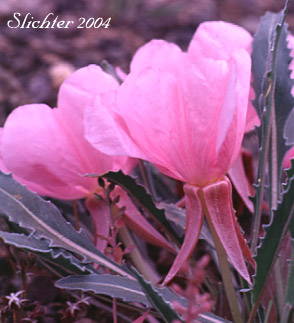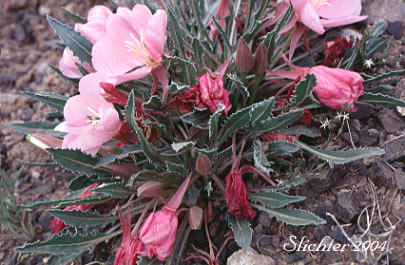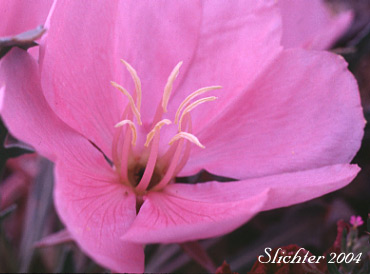 The
photo at right shows a close-up of the flower of desert evening-primrose as seen
south of Prineville, OR (to the north of US Highway 20).....May 27, 2000.
Note the separate, reflexed sepals which are lance-shaped and
measure from 2-4.5 cm in length. Note also the coarsely toothed to pinnatifid
leaves and the long, hollow floral tubes between the sepals.
The
photo at right shows a close-up of the flower of desert evening-primrose as seen
south of Prineville, OR (to the north of US Highway 20).....May 27, 2000.
Note the separate, reflexed sepals which are lance-shaped and
measure from 2-4.5 cm in length. Note also the coarsely toothed to pinnatifid
leaves and the long, hollow floral tubes between the sepals.
Desert evening-primrose is also known as rock-rose or butte primrose. Although sometimes referred to as sand lily, desert evening-primrose is not a lily. It is a taprooted perennial of the intermountain, desert west which grows up to 30 cm tall. Plants are either solitary or may appear colonial as spreading roots may give rise to new plants when they reach the soil surface. The herbage varies from glabrous to densely short-hairy or even villous. The stems are either short and stocky or absent. The leaves are crowded on the short stem and appear largely basal. The leaves range from 3-30 cm long and 0.5-4 cm wide. The margins are variable, depending on variety, ranging from entire to toothed or pinnatifid. The petioles vary from short to long.
The nocturnal flowers are numerous,borne singly from the axils. They are sessile or on stout pedicels up to 3 cm long. The flower buds are erect or spreading with glabrous surfaces. Opening shortly after sunset, the flowers are sweet scented and pollinated by hawkmoths, and then withering by the next day. The hollow floral tube is up to 14 cm long. The large, lanceolate sepals are large and separately reflexed during flowering. They measure from 2-4.5 cm long. The petals are large and showy, measuring from 2-5 cm long and generally white upon opening and aging to pink or rose-purple. The distal ends of the petals are broadly obcordate. The anthers are 9-7 mm long. The fruit is a more or less erect capsule from 2.5-5 cm long and up to 1 cm thick. The capsule is lance-ovoid , elliptic-ovoid, or subcylindric in shape.
Variety caespitosa: Flowers smaller, the floral tubes 3.5-7 cm long and the petals 2-4 cm long. The petals are white, aging to rose-purple. The leaves are toothed or nearly entire. The herbage is glabrous, subglabrous or puberulent (fine, short hairs) , the hairs less than 0.5 mm long. In the Pacific Northwest, it is found from central Washington south through central Oregon into northern Nevada.
Variety marginata: Flowers large with the floral tube 7-14 cm long and the petals 3-5 cm long. The petals are white, aging to pink. The leaves are ragged-toothed or somewhat pinnatifid. The herbage is noticeably hairy, the hairs spreading out beyond the margins of the leaves. In the Pacific Northwest, it is found from southeastern Washington and Idaho and south through central Oregon to California and Nevada.
Desert evening-primrose typically is found on dry, sandy to gravelly soils from the valleys and plains to well up in the mountains, sometimes even above timberline.
Desert evening-primrose is found across much of the arid western United States. It is found east of the Cascade Mts. and Sierra Nevada Mts. from central Washington south through central Oregon to California and into Mexico and east to the Great Plains.

